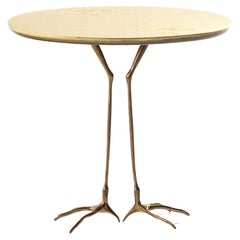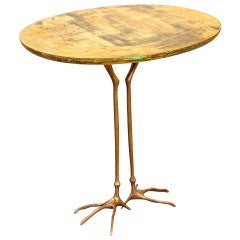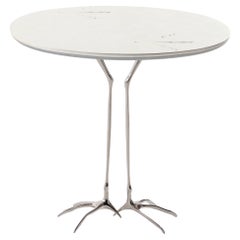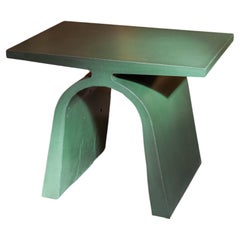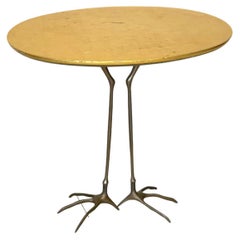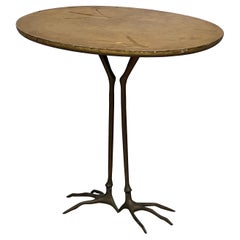Meret Oppenheim Furniture
Though the fame of the sculptor and painter Meret Oppenheim stems mainly from a single work of art, that one was a doozy. Known as Object, the enduringly disconcerting fur-covered teacup, saucer and spoon that Oppenheim created in 1936 remains the one of the most notorious works to spawn from the Surrealist art movement.
Born in Germany and raised in Basel, Switzerland, Oppenheim was encouraged to pursue art by her maternal grandmother, a writer and illustrator. Oppenheim moved to Paris to attend art school in 1932. There, she met the sculptor (and fellow Swiss native) Alberto Giacometti, who introduced her to Man Ray, Max Ernst and André Breton, the founder of the Surrealist movement. Within a year, Oppenheim was exhibiting her paintings with the Surrealists, the first female artist to do so.
Object, the story goes, was born of a lunchtime chat that Oppenheim had with Pablo Picasso and his muse, artist Dora Maar, one afternoon in 1936. The Spanish-born artist admired an unusual fur-lined bracelet that Oppenheim wore, and she replied that anything could be covered fur, “even this cup and saucer!” Her imagination fired, Oppenheim bought some china and a swatch of Chinese gazelle fur. When it was exhibited in New York, Object was purchased by the Museum of Modern Art — the first work of art by a woman acquired by the institution.
Another Oppenheim piece has become an icon of the art-as-design genre, a category that has currency among art collectors: the Traccia table, a side table with a gold- or silver-leafed wooden top, incised with the shapes of two bird-claw impressions, and a cast-bronze base in the form of stork legs. The Traccia — from the Italian for “track,” as in animal track — was created for the 1939 opening of art dealer Leo Castelli’s first gallery, on the Place Vendôme in Paris. The maker Simon International began producing versions of the Traccia in 1970, and the piece is now made by Cassina. Examples are typically priced between $6,300 and $8,500, depending on condition. As striking and amusing today as when it first appeared, the Traccia is an always-suave addition to a modern art and design collection and a tribute to the humor and ingenuity of a groundbreaking 20th-century artist.
Find original Meret Oppenheim art and furniture on 1stDibs.
1970s Italian Mid-Century Modern Vintage Meret Oppenheim Furniture
Brass, Gold Leaf
2010s Italian Mid-Century Modern Meret Oppenheim Furniture
Steel
2010s Italian Mid-Century Modern Meret Oppenheim Furniture
Steel
1980s Italian Mid-Century Modern Vintage Meret Oppenheim Furniture
Bronze, Gold Leaf
1970s Italian Mid-Century Modern Vintage Meret Oppenheim Furniture
Bronze
2010s Italian Mid-Century Modern Meret Oppenheim Furniture
Steel
2010s Italian Mid-Century Modern Meret Oppenheim Furniture
Bronze
2010s Italian Mid-Century Modern Meret Oppenheim Furniture
Steel
1970s Italian Mid-Century Modern Vintage Meret Oppenheim Furniture
Bronze
1970s Italian Mid-Century Modern Vintage Meret Oppenheim Furniture
Bronze, Gold Leaf
2010s Italian Mid-Century Modern Meret Oppenheim Furniture
Steel
1970s Italian Mid-Century Modern Vintage Meret Oppenheim Furniture
Bronze, Gold Leaf
20th Century Italian Mid-Century Modern Meret Oppenheim Furniture
Brass, Gold Leaf
2010s Italian Brutalist Meret Oppenheim Furniture
Concrete
2010s Italian Brutalist Meret Oppenheim Furniture
Concrete
Mid-20th Century Italian Mid-Century Modern Meret Oppenheim Furniture
Steel, Chrome
2010s Mexican Post-Modern Meret Oppenheim Furniture
Resin, Wood
2010s Mexican Post-Modern Meret Oppenheim Furniture
Stone, Marble, Onyx
1970s Italian Mid-Century Modern Vintage Meret Oppenheim Furniture
Granite
1970s Italian Mid-Century Modern Vintage Meret Oppenheim Furniture
Carrara Marble
1960s Italian Modern Vintage Meret Oppenheim Furniture
Wood
Mid-20th Century Italian Mid-Century Modern Meret Oppenheim Furniture
Steel, Chrome
1970s Italian Minimalist Vintage Meret Oppenheim Furniture
Stainless Steel
Late 20th Century American Modern Meret Oppenheim Furniture
Lacquer
21st Century and Contemporary Italian Modern Meret Oppenheim Furniture
Steel
1970s Italian Vintage Meret Oppenheim Furniture
Gold Leaf
1970s Vintage Meret Oppenheim Furniture
Brass
1970s Italian Vintage Meret Oppenheim Furniture
Gold Leaf
1970s Italian Mid-Century Modern Vintage Meret Oppenheim Furniture
Bronze, Gold Leaf
1970s Italian Post-Modern Vintage Meret Oppenheim Furniture
Bronze, Gold Leaf
1970s Swiss Mid-Century Modern Vintage Meret Oppenheim Furniture
Bronze, Gold Leaf
1970s Italian Mid-Century Modern Vintage Meret Oppenheim Furniture
Bronze
1970s Italian Mid-Century Modern Vintage Meret Oppenheim Furniture
Bronze, Gold Leaf
1930s German Mid-Century Modern Vintage Meret Oppenheim Furniture
Brass
Late 20th Century French Mid-Century Modern Meret Oppenheim Furniture
Bronze, Gold Leaf
1970s Italian Post-Modern Vintage Meret Oppenheim Furniture
Bronze, Gold Leaf
20th Century Mid-Century Modern Meret Oppenheim Furniture
Metal
Meret Oppenheim furniture for sale on 1stDibs.
Creators Similar to Meret Oppenheim
- 1stDibs ExpertJanuary 19, 2025Meret Oppenheim is famous for her work as a Surrealist artist. One of her best-known pieces is Object, an enduringly disconcerting fur-covered teacup, saucer and spoon that Oppenheim created in 1936. The story goes, it was born of a lunchtime chat that Oppenheim had with Pablo Picasso and his then-muse, artist Dora Maar. The Spanish-born artist admired an unusual fur-lined bracelet Oppenheim wore, and she replied that anything could be covered with fur, “even this cup and saucer!” Her imagination fired, and Oppenheim bought some china and a swatch of Chinese gazelle fur. When it was exhibited in New York, Object was purchased by the Museum of Modern Art. It was the first work of art by a woman acquired by the institution. On 1stDibs, find a selection of Meret Oppenheim art and furniture.
- 1stDibs ExpertOctober 15, 2024Most experts state that Meret Oppenheim was part of Surrealism, not Dada. Oppenheim moved to Paris to attend art school in 1932. There, she met sculptor Alberto Giacometti, who introduced her to Man Ray, Max Ernst and André Breton, considered the founder of the Surrealist movement. Within a year, Oppenheim was exhibiting her paintings with the Surrealists, the first female artist to do so. One of her most famous works is the 1936 Object, the enduringly disconcerting fur-covered teacup, saucer and spoon. On 1stDibs, shop a variety of Meret Oppenheim art and furniture.

